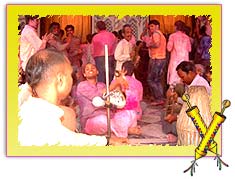સન્તા ઃ સ્વામીજી ઇન્સાન કો જબ ભી કોઈ પ્રોબ્લેમ હો તો ઉસે કહાં જાના ચાહિયે ?
સ્વામીજી ઃ કિસાન કે પાસ.
સન્તા ઃ કયુ ?
સ્વામીજી ઃ કયું કિ ઉસ કે પાસ ‘હલ’ હોતા હૈ !
* * *
- કે તરત જ એમણે ઘરના તમામ સભ્યોને બોલાવીને હુકમ કર્યો, ‘હવે કોઈએ વા-છૂટ કરવાની નથી ! ગેસ બચાવો !’
* * *
‘કાર્તિક મિસ-કોલિંગ કાર્તિક’ !
* * *
અને પહેલું દુઃખ તે ?...
...
...
ફેરા ફર્યા !
* * *
સન્તાના ૩૫ રન થઇ ગયા.
તરત જ એ બેટ ઉંચું કરીને, હેલ્મેટ કાઢીને, ઉછળી-કૂદીને, મુઠ્ઠી ઉગામીને નાચવા લાગ્યો.
સચિને પૂછયું ઃ ‘યાર, તારા ૫૦ રન નથી થયા, ૧૦૦ રન નથી થયા, છતાં આટલો કેમ કૂદે છે ?’
સન્તા કહે ‘તુમ કૈસે સમજોગે ? સિર્ફ ગ્રેજ્યુએટ લોગ સમજતે હૈં કિ ૩૫ કા આંકડા કયા હોતા હૈ !’
* * *
(૧) પેન્સિલ વડે
(૨) પેન વડે
(૩) માર્કર વડે
તમને કઈ રીત પસંદ છે ?
* * *
એ લોકો મર્યા પછી નરકમાં જાય છે. અને એકબીજાને કહે છે ‘યાર, પેલા યમદૂતની વાઇને જોઈ ? શું આઇટમ છે યાર !’
* * *
બેવકૂફ નર + સ્માર્ટ નારી = જેબ ખાલી
સ્માર્ટ નર + બેવકૂફ નારી = પાંવ ભારી
બેવકૂફ નર + બેવકૂફ નારી + હો ગઈ શાદી !
* * *
હવે મને સમજાય છે
હૈયું મારું કેવું
બળી બળી જાય છે
હું બેઠો છું
એની જ સાથે, છતાં
જોયું ? મારી બેટી
એકલી એકલી જ
શીંગ ખાય છે !
* * *
અંજામ પાયા હૈ...
હાથ-પૈર તૂટે હૈં
મુંહ સે ખૂન આયા હૈ...
હોસ્પિટલ પહુંચે તો
નર્સને ફરમાયા હૈ...
બહારોં ફૂલ બરસાઓ
કિસી કા મહેબૂબ આયા હૈ !
* * *
કયા છૂપાતી થી
કુછ થા ઉસ કે હોઠોં પે
મગર વો શરમાતી થી
જબ હમ ને મુંહ
ખુલવા કે દેખા તો...
સાલી ‘માનિકચંદ’ ખાતી થી !
* * *
બન્તા ઃ અચ્છા ? કૌન સે કલર કા ?
* * *
આંખો મેં નમી થી
વિટામીન કી કમી થી
જીન સે મોબાઈલ પે
સારી રાત બાત કી
વો તો મેરી ગર્લફ્રેન્ડ કી મમ્મી થી !
* * *
Mom & God is neither Male, nor female, niether child, nor adult, niether black, nor white, but loves children very much.
Kid & Oh ! MICHAEL JACK SON !
સ્વામીજી ઃ કિસાન કે પાસ.
સન્તા ઃ કયુ ?
સ્વામીજી ઃ કયું કિ ઉસ કે પાસ ‘હલ’ હોતા હૈ !
* * *
કરકસર=
કંજુસ દમડીલાલે જેવું છાપામાં વાંચ્યું કે ‘હવે ગેસના ભાવમાં ૨૫ ટકાનો વધારો થવાનો છે’....- કે તરત જ એમણે ઘરના તમામ સભ્યોને બોલાવીને હુકમ કર્યો, ‘હવે કોઈએ વા-છૂટ કરવાની નથી ! ગેસ બચાવો !’
* * *
લો-બજેટ ટાઇટલ=
જો ‘કાર્તિક, કોલિંગ કાર્તિક’ સાવ લો-બજેટ ફિલ્મી હોત તો એનું નામ શું હોત ?‘કાર્તિક મિસ-કોલિંગ કાર્તિક’ !
* * *
આજનો સુવિચાર=
પહેલું સુખ તે ‘જાતે નર્યા’અને પહેલું દુઃખ તે ?...
...
...
ફેરા ફર્યા !
* * *
૩૫ રનનો રેકોર્ડ=
એક ફેસ્ટિવલ મેચમાં સન્તા સચિનની જોડે બેટિંગ કરી રહ્યો હતો.સન્તાના ૩૫ રન થઇ ગયા.
તરત જ એ બેટ ઉંચું કરીને, હેલ્મેટ કાઢીને, ઉછળી-કૂદીને, મુઠ્ઠી ઉગામીને નાચવા લાગ્યો.
સચિને પૂછયું ઃ ‘યાર, તારા ૫૦ રન નથી થયા, ૧૦૦ રન નથી થયા, છતાં આટલો કેમ કૂદે છે ?’
સન્તા કહે ‘તુમ કૈસે સમજોગે ? સિર્ફ ગ્રેજ્યુએટ લોગ સમજતે હૈં કિ ૩૫ કા આંકડા કયા હોતા હૈ !’
* * *
લાઇન મારો !
લાઈન મારવાની ૩ રીતો છે.(૧) પેન્સિલ વડે
(૨) પેન વડે
(૩) માર્કર વડે
તમને કઈ રીત પસંદ છે ?
* * *
મસ્તીમાર દોસ્ત
અસલી મસ્તીમાર દોસ્તો કોને કહેવાય ?એ લોકો મર્યા પછી નરકમાં જાય છે. અને એકબીજાને કહે છે ‘યાર, પેલા યમદૂતની વાઇને જોઈ ? શું આઇટમ છે યાર !’
* * *
સમીકરણો
સ્માર્ટ નર + સ્માર્ટ નારી = અફેર જારીબેવકૂફ નર + સ્માર્ટ નારી = જેબ ખાલી
સ્માર્ટ નર + બેવકૂફ નારી = પાંવ ભારી
બેવકૂફ નર + બેવકૂફ નારી + હો ગઈ શાદી !
* * *
રે પસ્તાવો...
પ્રેમની કિંમતહવે મને સમજાય છે
હૈયું મારું કેવું
બળી બળી જાય છે
હું બેઠો છું
એની જ સાથે, છતાં
જોયું ? મારી બેટી
એકલી એકલી જ
શીંગ ખાય છે !
* * *
અંજામ-એ-ઈશ્ક
ઇશ્ક મેં યે કૈસાઅંજામ પાયા હૈ...
હાથ-પૈર તૂટે હૈં
મુંહ સે ખૂન આયા હૈ...
હોસ્પિટલ પહુંચે તો
નર્સને ફરમાયા હૈ...
બહારોં ફૂલ બરસાઓ
કિસી કા મહેબૂબ આયા હૈ !
* * *
રહસ્યમય પ્રેમિકા
ના જાને વો હમ સેકયા છૂપાતી થી
કુછ થા ઉસ કે હોઠોં પે
મગર વો શરમાતી થી
જબ હમ ને મુંહ
ખુલવા કે દેખા તો...
સાલી ‘માનિકચંદ’ ખાતી થી !
* * *
નવી ખરીદી
સન્તા ઃ કલ મૈં નયા કલર ટીવી લાયા..બન્તા ઃ અચ્છા ? કૌન સે કલર કા ?
* * *
નવો લોચો
અર્ઝ કિયા હૈ...આંખો મેં નમી થી
વિટામીન કી કમી થી
જીન સે મોબાઈલ પે
સારી રાત બાત કી
વો તો મેરી ગર્લફ્રેન્ડ કી મમ્મી થી !
* * *
ONE IN ENGLISH
Kid & Mom, Who is God ?Mom & God is neither Male, nor female, niether child, nor adult, niether black, nor white, but loves children very much.
Kid & Oh ! MICHAEL JACK SON !
RAJ

 The festival of Holi also finds a reference in the sculptures on walls of old temples. A 16th century panel sculpted in a temple at Hampi, capital of Vijayanagar, shows a joyous scene of Holi. The painting depicts a Prince and his Princess standing amidst maids waiting with syringes or pichkaris to drench the Royal couple in coloured water.
The festival of Holi also finds a reference in the sculptures on walls of old temples. A 16th century panel sculpted in a temple at Hampi, capital of Vijayanagar, shows a joyous scene of Holi. The painting depicts a Prince and his Princess standing amidst maids waiting with syringes or pichkaris to drench the Royal couple in coloured water. 



